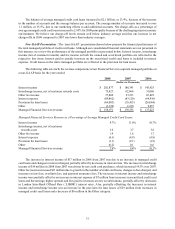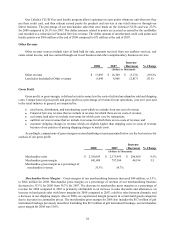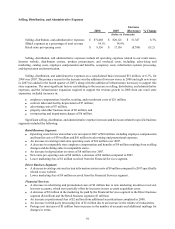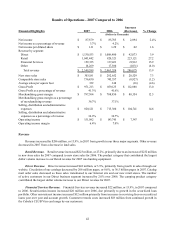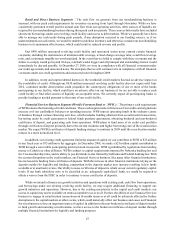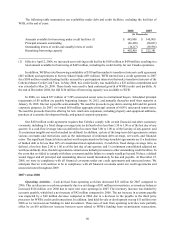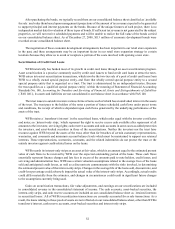Cabela's 2008 Annual Report Download - page 52
Download and view the complete annual report
Please find page 52 of the 2008 Cabela's annual report below. You can navigate through the pages in the report by either clicking on the pages listed below, or by using the keyword search tool below to find specific information within the annual report.47
Retail and Direct Business Segments – The cash flow we generate from our merchandising business is
seasonal, with our peak cash requirements for inventory occurring from April through November. While we have
consistently generated overall positive annual cash flow from our operating activities, other sources of liquidity are
required by our merchandising business during these peak cash use periods. These sources historically have included
short-term borrowings under our revolving credit facility and access to debt markets. While we generally have been
able to manage our cash needs during peak periods, if any disruption occurred to our funding sources, or if we
underestimated our cash needs, we would be unable to purchase inventory and otherwise conduct our merchandising
business to its maximum effectiveness, which could result in reduced revenue and profits.
Our $430 million unsecured revolving credit facility and unsecured senior notes contain certain financial
covenants, including the maintenance of minimum debt coverage, a fixed-charge coverage ratio, a cash flow leverage
ratio, and a minimum tangible net worth standard. In the event that we failed to comply with these covenants and the
failure to comply would go beyond 30 days, a default would trigger and all principal and outstanding interest would
immediately be due and payable. At December 27, 2008, we were in compliance with all financial covenants under
our credit agreements and unsecured notes. We anticipate that we will continue to be in compliance with all financial
covenants under our credit agreements and unsecured notes throughout 2009.
In addition, recent and unprecedented distress in the worldwide credit markets has had an adverse impact on
the availability of credit. Although our $430 million unsecured revolving credit facility does not expire until June
2012, continued market deterioration could jeopardize the counterparty obligations of one or more of the banks
participating in our facility, which could have an adverse effect on our business if we are not able to replace such
credit facility or find other sources of liquidity on acceptable terms. We currently expect all participating banks to
provide funding as needed pursuant to the terms of our credit facility.
Financial Services Business Segment (World’s Foremost Bank or “WFB”) – The primary cash requirements
of WFB relate to the financing of credit card loans. These cash requirements will increase if our credit card originations
increase or if our cardholders’ balances or spending increase. WFB sources operating funds in the ordinary course
of business through various financing activities, which includes funding obtained from securitization transactions,
borrowing under its credit agreement or federal funds purchase agreements, obtaining brokered and non-brokered
certificates of deposit, and generating cash from operations. WFB plans to fund more of its credit card portfolio
through certificates of deposit primarily due to the current weakness and higher borrowing costs of the securitization
market. We expect WFB’s certificates of deposit funding strategy to continue in 2009 until the securitization market
returns to a more normalized level.
In addition, our existing credit agreement limits the amount of capital we can contribute to WFB to $25 million
in any fiscal year or $75 million in the aggregate. In December 2008, we made a $25 million capital contribution to
WFB through a convertible participating preferred stock investment. WFB is prohibited by regulations from lending
money to Cabela’s or other affiliates. WFB is subject to capital requirements imposed by Nebraska banking law and
the Visa membership rules, and its ability to pay dividends is also limited by Nebraska and Federal banking law. With
the current disruptions in the credit markets, our Financial Services business, like many other financial institutions,
has increased its funding from certificates of deposits. With the increase in other financial institutions relying on the
deposits market for liquidity and funding, competition in the deposits market may increase resulting in less funds
available or at unattractive rates. Our ability to issue certificates of deposit is reliant on our current regulatory capital
levels. If our bank subsidiary were to be classified as an “adequately capitalized” bank, we would be required to
obtain a waiver from the FDIC in order to continue to issue certificates of deposits.
While we intend to finance our growth initiatives and operations with existing cash, cash flow from operations,
and borrowings under our existing revolving credit facility, we may require additional financing to support our
growth initiatives and operations. However, due to the existing uncertainty in the capital and credit markets, our
access to capital may not be available on terms acceptable to us or at all. Further, the ability of our Financial Services
business to engage in securitization transactions on favorable terms or at all could be adversely affected by further
disruptions in the capital markets or other events, which could materially affect our business and cause our Financial
Services business to lose an important source of capital. In addition to the non-brokered certificates of deposit market
to fund growth and maturing securitizations, we have access to the brokered certificates of deposit market through
multiple financial institutions for liquidity and funding purposes.


